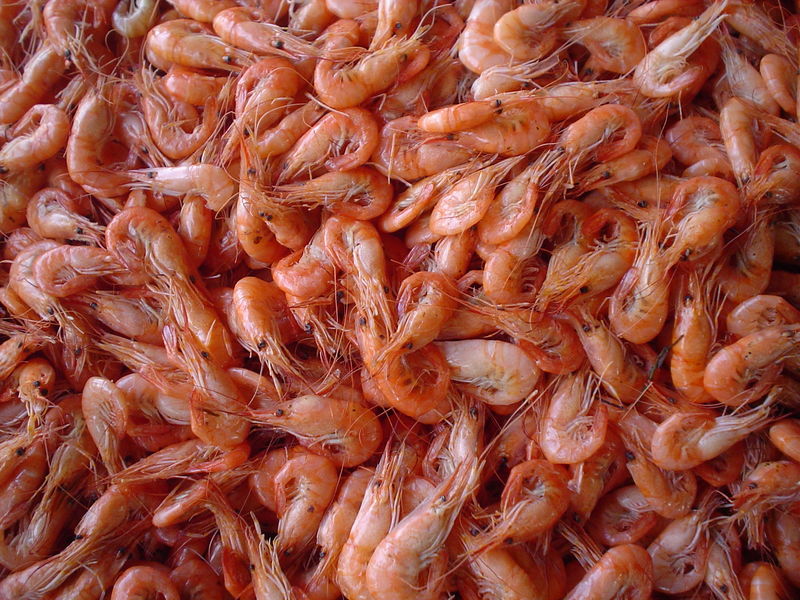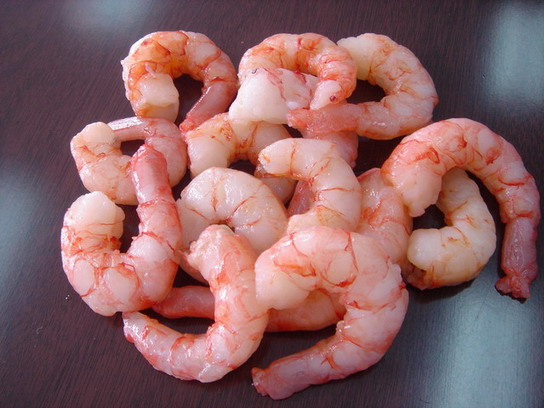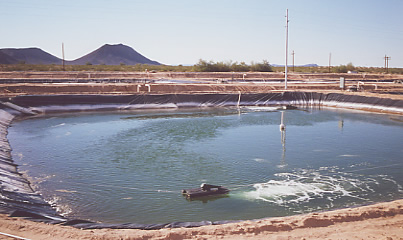SHRIMP FARMING

INTRODUCTION
India is endowed with a long coastline and hence offers scope for large exploitation of marine wealth. Till a few years back, fishermen in India were involving themselves in traditional marine fishing. In the seventies fishermen started concentrating on catching prawns more commonly known as `shrimps' due to high profitable return on the same on account of their export value. Brackish water prawn farming started in a big way during 91-94 especially in the coastal districts of Andhra Pradesh and Tamil Nadu. Subsequently due to disease problems, litigation in supreme court and other social and environmental problems the sector suffered a huge set back and most of the corporate farms were closed. However, the small units continued to do farming and adopting extensive prawn farming systems. The shrimp farming has now been regulated with the establishment of Aquaculture Authority of India as per directions of Supreme Court for issuing licenses and overall supervision. It is commonly said that after Green and White Revolution in India, it is time for Blue Revolution to exploit the huge potential in fisheries sector. Shrimps are called the "Pinkish Gold" of the sea because of its universal appeal, unique taste, high unit value and increasing demand in the world market.
2. Scope for brackish water shrimp farming
The over exploitation of shrimp from natural sources and the ever increasing demand for shrimp and shrimp products in the world market has resulted in the wide gap between the demand and supply shrimp in the International market. This has necessitated the need for exploring new avenues for increasing prawn production. The estimated brackish water area suitable for undertaking shrimp cultivation in India is around 11.91 lakhs ha. spread over 10 states and union territories viz... West Bengal, Orissa, Andhra Pradesh, Tamil Nadu, Pondicherry, Kerala, Karnataka, Goa, Maharashtra and Gujarat. Of this only around 1.2 lakhs ha. are under shrimp farming now and hence lot of scope exists for entrepreneurs to venture into this field of activity. The following table gives the state-wise potential and present level of development as on March 1996.
Sr. No |
State |
Estimated brackish water area
(ha.) |
Area under cultivation (ha.) |
1 |
West Bengal |
405,000 |
34,660 |
2 |
Orissa |
31,600 |
11,000 |
3 |
Andhra Pradesh |
150,000 |
50,000 |
4 |
Tamil Nadu |
56,000 |
2,879 |
5 |
Pondicherry |
800 |
37 |
6 |
Kerala |
65,000 |
14,657 |
7 |
Karnataka |
8,000 |
3,500 |
8 |
Goa |
18,500 |
650 |
9 |
Maharashtra |
80,000 |
716 |
10 |
Gujarat |
376,000 |
884 |
|
1,190,000 |
118,983 |

Location of the project
The first and foremost requirement for entering into this venture is the acquisition of suitable land. The details of land identified/surveyed in coastal districts are available with the department of fisheries of the concerned State Governments and with the Regional offices of the MPEDA functioning in the coastal states of India. A suitable site is one that can support optimum conditions for the growth of shrimps at targetted production level. Most of the lands available along the coastline are owned by the State Governments. In some cases, the entrepreneur has to get it on long term lease from the revenue authorities of the State Government. If it is a private land, one has to preferably purchase on outright basis. While selecting the site for the project, the entrepreneur should ensure the following :
i) Area should be accessible preferably by a road even during the monsoon season.
ii) Mangrove area with large tree stumps should not be selected.
iii) Site should have good pollution free water supply of both freshwater and brackish water. Water quality parameters required for maximum feed efficiency and maximum growth of Penaeus monodon are given below
S.No |
Water Parameters |
Optimum level |
1 |
Dissolved Oxygen |
3.5-4 ppm |
2 |
Salinity |
10-25 ppt |
3 |
Water Temperature |
26-32 (C 0) |
4 |
pH |
6.8-8.7 |
5 |
Total nitrite nitrogen |
1.0 ppm |
6 |
Total ammonia (less than) |
1.0 ppm |
7 |
Biological Oxygen Demand (BOD) |
10 ppm |
8 |
Chemical Oxygen Demand (COD) |
70 ppm |
9 |
Transparency |
35 cm |
10 |
Carbon dioxide (less than) |
10 ppm |
11 |
Sulphide (less than) |
0.003 ppm |
iv) The areas should be flood free
v) Location with a natural slope, for proper drainage should be selected.
vi) Social problems due to competing use of water resources and drainage of waste water should be properly taken care of.
vii) Availability of necessary infrastructure namely electricity, ice factory, cold storage, communication facilities etc., are necessary for successful management.
4. Borrowers' profile
Complete details of the entrepreneurs, partnership firm, registered company should be given. Qualification and experience of the promoters, net worth of the borrowers, other activities undertaken by them, financial ability etc., have to be furnished.
5. Technical feasibility of the project
As the project envisaged new technologies, the borrowers may take the help of a competent outside agency to prepare the technical feasibility report on the project. However, to serve as a guidelines to the entrepreneurs in this regard the technical parameters are given in Annexure-I. However, the first and foremost requirement of the project is to get a license from Aquaculture Authority as per the existing norms and as per guidelines issued by Supreme Court.
6. Physical and financial outlay
Details of the physical and financial outlays involved for setting up of 5 ha. Brackish water prawn farm are furnished in Annexure No.II. It can be seen therefrom that the total cost including working capital expenses for raising the first crop for a 5 ha. Prawn farm works out to Rs.37.60 lakhs. While submitting the project to the banks for sanction of loan entrepreneurs are expected to submit detailed plan and estimates for all the civil works to be undertaken as also invoices of various items to be purchased from the suppliers.
7. Margin money and bank loan
The entrepreneur has to bring in 25% of the project cost out of his own resources and the balance of 75% will be provided by banks as bank loan. However, NABARD could consider providing margin money loan assistance in suitable and eligible cases as per the guidelines contained in circular no. DPD 67/92-93 dated 24.2.1993.
8.Marketing
Because of huge gap between supply and demand of shrimps in local as well as international market, there may not be any problem in marketing the same. Shrimps can either be sold directly by the farmers in the market or sold to exporters for processing before export. Shrimps can be exported in frozen form with head on , head less, battered and breaded, or IQF products or any other form with value addition. The prawn has to be packed as per requirements of importing countries and therefore this should be decided after a detailed market survey. It is always advisable to get in touch with local distributing agents of the customer country. Hygienic packaging, display and appearance of the packet are key factors to attract consumers of importing countries.
Technical Parameters for establishing a extensive shrimp farm
A -1. Design and Construction of shrimp farm :
An extensive shrimp farm should be of the size 0.4 - 0.5 ha. and preferably drainable from the management point of view. The ponds generally should have concrete dikes, elevated concrete supply canal with separate drain gates and adequate life supporting devices like generators and aerators.
The design, elevation and orientation of the water canals must be related to the elevation of the area with particular reference to the mean range of tidal fluctuation. The layout of the canals and dikes may be fitted as closely as technically possible to existing land slopes and undulation for minimizing the cost of construction.
2. General Earth Work
It is normally carried out in the following order :
1. Site clearing
2. Top soil stripping
3. Staking of centre lines and templates
4. Preparation of dike foundation
5. Excavation of drainage canals
6. Construction of dikes (peripheral and secondary)
7. Forming and compaction of dikes.
8. Excavation of pits for gates.
9. Levelling of pond bottom.
10. Construction of gates and refilling of pits
11. Construction of dike protection.
The top soil may be set aside and should again be spread later to preserve pond bottom fertility.
3. The essential components of a shrimp farm are :-
1. Ponds
2. Water intake structure
3. Store room for feed and equipments
4. An area for cleaning of the harvest
5. A workshop and pump house
6. Watch and ward room , office and a mini laboratory.
B. Ponds
From the management point of view it is better to go in for ponds of 0.4 ha-0.5 ha size. These ponds should be preferably completely drainable. The ponds are partitioned by secondary dykes. In order to render over all protection to the cultured stock and all related structures a perimeter dyke also can be constructed.
The height of the perimeter dyke will depend upon the following factors, such as :
1. Height of water level in the area.
2. Elevation above mean sea level.
3. Height of free board.
4. The percentage allowance for soil shrinkage.
The partition dykes determine the size and limit of each grow out pond and its height is determined by the following factors namely :
1. The height of water column in the pond
2. Free board
3. Wave action
4. Shrinkage factor
The shrinkage factor is decided by the type of soil like heavy, medium and light soils.
C. Gates
They regulate the inflow and outflow of water into the pond and also are responsible for maintaining the desired water column in the pond. The main gates are constructed on the perimeter dyke and are usually located on the partition dykes and they regulate the water column in the individual ponds. It can be made out of concrete or PVC or Asbestos piping.
D. Drain canals
They are generally trapezoidal in cross section and its discharge capability is decided by area of cross section and velocity of water flow.
E. Pond preparation
Proper pond preparation will ensure higher production. The main objectives of pond preparation are :
1. To eradicate weed fishes and orgnaisms
2. To remove abnoxious gases
3. To improve the natural productivity of the pond eco system
4. To maintain high water quality for proper growth and higher survival percentage.
Eradication of unwanted organisms is usually carried out by draining out the entire water and drying the pond bottom till it cracks. This also helps in removal of obnoxious gases and oxygenation of the pond bottom. It also improves the fertility of the soil.
Liming is done for correcting the pH and to kill pathogenic bacteria and virus. In undrainable ponds mahual oil should be applied @ 200 ppm to eradicate the weed fishes. After around two weeks time organic and inforanic fertilisers are applied to enrich the soil and water. Once the thick lab-lab is formed the water level is raised and the pond is made ready for stocking.

F. Selective stocking :
The most suitable species for culture in India are the Indian white prawn Penaeus indicus and tiger prawn P. Monodon. The stocking density varies with the type of system adopted and the species selected for the culture. As per the directives of Supreme Court only traditional and improved traditional shrimp farming can be undertaken within the CRZ with a production range of 1 to 1.5 tonnes/ha/crop with stocking density of 40,000 to 60,000/ha/crop. Outside CRZ extensive shrimp farming with a production range of 2.5 to 3 tonnes/ha/crop with stocking density of 1,00,000/ha/crop may be allowed.
In order to have uniform growth of the cultured animal it is always advisable to go in for hatchery reared seeds.
|
|
G. Food and feeding
Shrimp diets may be supplementary or complete. In a extensive system the shrimps need a complete diet. Although natural food items have good conversion values but they are difficult to procure in large quantities and maintain a continuous supply.
At present most of the aquaculture farms depend on imported feed with a FCR of 1:1.5 - 1.8. The feeding could be done by using automatic feed dispensers, or by broadcasting all over the pond. If feeding trays are employed in selected pockets in the pond wastage in feed can be reduced.
H. Harvesting :
Complete harvesting can be carried out by draining the pond water through a bag net and hand picking. The average culture period required is around 120-150 days during which time the prawns will grow to 20-30 gm size (depending on the species). It is possible to get two crops in a year. Harvested shrimps can be kept between layers of crushed ice before transporting the consignment to market.
Estimated physical and financial outlay involved for setting up of a shrimp farm
|
A. |
CAPITAL COST |
Rs. lakhs |
a) |
Earth work for construction of ponds, drainages and feeder canals etc. (20000 m 3) Rs.25/m3 |
'5.0 |
b) |
Lining of feeder canal |
0.7 |
c) |
Water inlet structure for ponds (2 Nos.) |
0.5 |
d) |
Water outlet structure for ponds (10 Nos.) |
1 |
c) |
Main outlet sluices (2 Nos.) |
0.3 |
d) |
Pump House, generator shed cum workshop etc |
1 |
g) |
Office, laboratory and stores |
2 |
h) |
Watchman shed |
0.2 |
i) |
Drinking water storage and supply network |
0.75 |
j) |
Pumps (3 Nos. Mixed flow pump of 25 HP each) |
2.55 |
k) |
Aerators (10 Nos. 1 HP) |
2 |
l) |
Electrical installations |
2 |
m) |
Generators (7 nos. X 30 KVA) |
4 |
n) |
Lab and farm equipments` |
1 |
o) |
Miscellaneous expenditure |
1 |
|
TOTAL |
24 |
B. |
OPERATIONAL COST FOR THE FIRST CROP |
|
a) |
Seed @ Rs.300/1000 Nos. For 2 lakh |
3 |
b) |
Feed @ Rs.40/kg for 15,000 kg |
6 |
c) |
Chemicals and manures for pond preparation (@ Rs.15,000/ha) |
0.75 |
d) |
Fuel and electricity |
1.5 |
e) |
Repairs and maintenance |
0.5 |
f) |
Harvesting |
0.25 |
g) |
Labour for pond preparation |
0.2 |
h) |
Staff salary |
0.92 |
|
1 Farm manager 10,000 x 4 |
|
|
1 Mechanic 5,000 x 4 |
|
|
Farm hands (2) 4,000 x 4 |
|
|
Watchman (2) 4,000 x 4 |
|
i) |
Office expenses and Misc. expenses |
0.5 |
|
|
13.62 |
|
Total outlay for 5 Ha |
Rs.37.62 lakh Say 37.60 |
|
Total outlay per Ha. |
Rs.7.52 lakh appx. |
Note : 1) Detailed plan and estimates are to be furnished alongwith the project.
2) Invoices for purchase of various items to be enclosed.
Statement showing Financial Analysis for Shrimp Culture in 5 ha. Farm (Rs. lakhs)
|
|
I year |
II to VIII years |
|
A |
COST |
|
|
|
1 |
Fixed Cost |
24 |
-- |
|
2 |
Recurring Cost |
13.6 |
27.2 |
|
|
TOTAL COST |
37.6 |
27.2 |
|
B. |
BENEFIT |
25 |
50 |
|
|
NET INCOME |
-12.6 |
22.6 |
|
|
Discount Factor at 15% |
0.87 |
3.17 |
|
|
Net Present worth of cost |
-32.71 |
86.22 |
= 118.936 |
|
Net Present worth of benefits |
21.75 |
158.5 |
= 180.25 |
|
NPW at 15% discount factor |
61.314
BCR = 1.515 |
|
|
|
Discount factor at 50% |
0.67 |
1.25 |
|
|
NPW at 50% |
-8.44 |
28.25 |
= 19.808 |
|
|
Internal Rate of Return is more than 50% |
|
|
Source: www.nabard.org
|



